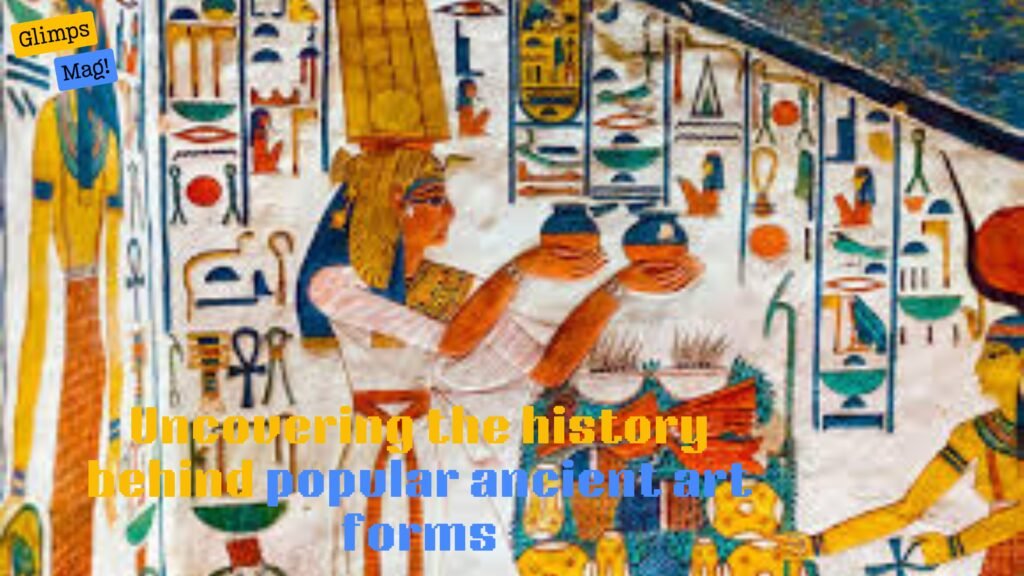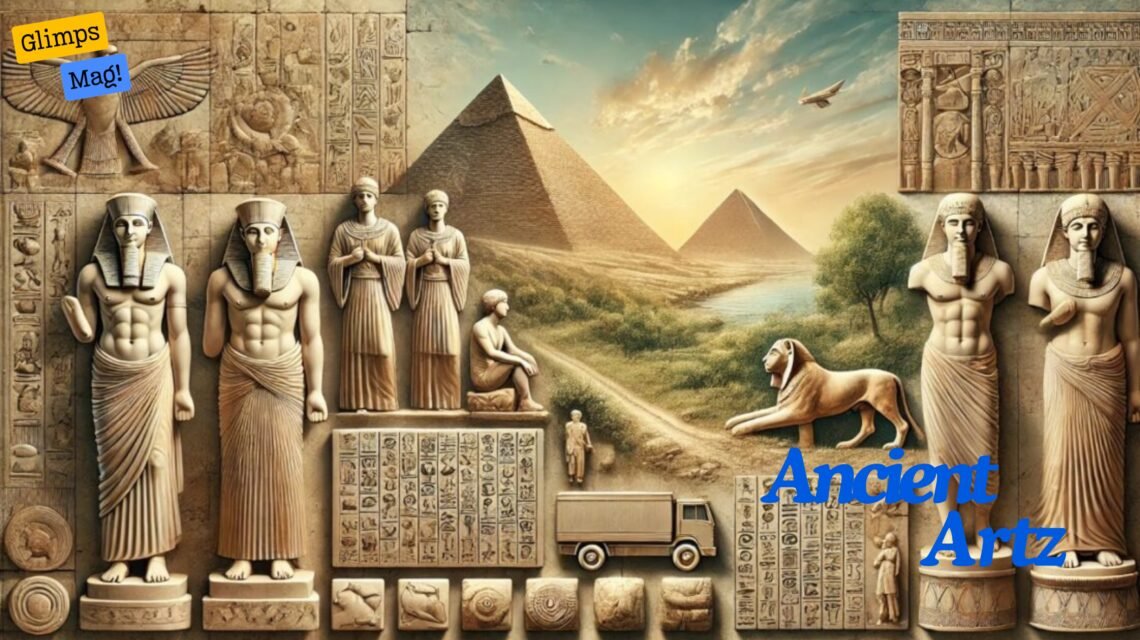Introduction: Ancient Artz
Be prepared to go on a voyage through a dimension in which artistry has no restrictions. The ‘Ancient Artz’ illustrates how creatively expressive humans have always been. This entices the reader to delve more into the history and intricacy of ancient expression. Starting from the detailed carved stones telling tales within them to decorated stone walls that once were dull, this trip in history shows how ancestors back then were able to share their memories and beliefs.
In the age of disposability and speed of the latest fads and new generation of the visually-oriented, it is not only a tribute to the past to look for these classic gems,it is about bringing all the people closer to understanding and experiencing culture. Come with us as we investigate the place of ancient art in the contemporary world and its place in today’s society, all in honor of the history that is present within the art.
Table of Contents
The significance and impact of ancient art on modern society
Ancient Artz has a lot of importance in the present world and much more to these in most people. It provides insight into the past, regarding the cultural themes and the beliefs of the Ancient Artz people.
The worldwide contribution to the artifacts then becomes two sided. While developing ideas from these old artifacts, most cross pollinate them with new ideas.
Besides, Ancient Artz art forms give a sense of self and belonging. They help us in a way that we remember the history and culture that is common to many generations.
Public artworks often contain elements from sculptures or wall paintings from history. Such works provoke thoughts related to history and art.
In the classroom, being exposed to ancient art enhances the syllabus. It sparks interest among learners about their cultures and the cultures of the world.
Today, this Ancient Artz beauty compels us to perceive things in a given way and inspires us to seek new possibilities for tomorrow.
Uncovering the history behind popular ancient art forms

Ancient art forms are narratives carved by time. Where every work of art is a representation of those cultures’ ideologies, practices and struggles. If we go back to the beginning, we would see how such people lived.
For example, Greek pots are recognizable to many over the world. These masterpieces of art adorned with beautiful designs mostly told of the mythology and the daily occurrences. They convey a lot in terms of social practices and devotion.
In the same manner, Ancient Artz Egyptian hieroglyphics unlock history as it was more pictorial than written. Every mark is very meaningful giving scope on politics and religion.
Engaging in these heroic arts of the ancestors enables us to reach somewhere deeper in the connection with the ancestors. Such creativity reflects human life of varied ages — a line still followed by humanity today.
Such histories help us bring to the surface not only masterpieces but rather the masterpieces of human creation — its achievements and miseries preserved — forever — in clay, stone, and colors.
The enduring beauty and relevance of Ancient Artz sculptures and architecture
Of all the art forms, Ancient Artz sculpture and architecture appeals to our senses and emotions in a rather unique way. Their details speak of stories of many decades gone behind but their charm is everlasting.
Take the Parthenon in Athens, for instance. This is a rare architectural work that consists of great analysis of proportions and ratios. Its columns seem to laugh at the time providing a glimpse of Greece’s Ancient Artz past.
The sculptures include such as the David by Michelangelo that depict human forms in more than just artistic aptitude but more so empathy of their emotions through movement. They challenge the beholder to see what beauty truly is.
Such works have not removed the creativity of the modern day sculptors and architects. Ancient Artz styles are often the basis traced for modern day constructions, this indicates that in every way history influences the current fashions.
These works of art even in the present serve as reminders of what every person possesses. Every generation has a value to contribute to art in every civilization and so all generations are united by art.
Rediscovering the intricacies of Ancient Artz paintings and murals
Ancient Artz cient paintings and murals do not just capture events, they also spins narratives from lost artifacts. Every single stroke of every brush is important and exotic since it feeds tales long lost to time.
The interesting artifacts of the cultures of Ancient Artz Egypt through the rich colors to the beautiful patterns found in the temples of Mesoamerica portray the managing values and heritage of their creators. They freeze aspects of everyday life, religious practices, and history.
As the artistic layers of these brute works unfold, they discover some methods of applying art in culture. The very long techniques of using natural colors are indicative of environmental roots.
In addition, the advanced technologies of our time facilitate looking to layers that cannot be touched. This procedure reveals things that were hidden beneath many years of debris.
The finding of these details enhances the appreciation of people and especially artists through their works. It beckons us to value that which we actively see and, even more so, that which most goes unarticulated yet is deeply experienced from one generation to another.
Reviving traditional music and dances from Ancient Artz civilizations
Bringing back the most authentic music and dances rooted in Ancient Artz cultures is perhaps the most exciting venture into the deepest recesses of who we are. These art forms preserve narratives, beliefs and passions that have been handed down through the ages.
There is a history behind every note played or step danced. Handcrafted instruments have their own stories. They were used in marking life chances by our far grandparents.
In recent times, it is these masters whose art forms such as weaving, carving, calligraphy are being resurrected. Such practices and festivals serve as an excellent platform where the people in the community can interact more with their culture.
Ritual dances that were once performed within holy precincts have found their way into performances of today. The old music combines with the new in a way that appeals to many.
Most importantly, such restoration is not only beneficial to the appreciative. It reinforces the fact that people not only create art but use it as a means of uniting different periods e.g. the past and present through their works of art.
Incorporating elements of ancient art into modern designs and fashion
Modern creativity still derives a lot from ancient art. More and more, designers are inspired by Ancient Artz designs and patterns. These elements make the modern pieces more classic in some aspects.
For instance, dresses with Ancient Artz tapestry patterns strategically placed can make a plain dress look extraordinary. In the same way, ornaments that bear the signs of nationality enable the wearer to wear history.
As for architecture, it would be a setback to argue otherwise. There is simply beauty in juxtaposing contemporary structures with the use of Ancient Artz ent pillars or arched shapes. People are able to relate to the bygone eras through such structures and thus enrich the city.
Probably the only branch that has not been affected is interior decoration. Plants in the form of Ancient Artz heads and vases bring delight as well as anchor the space in culture.
Appreciation for such artistic heritage is helpful for the designers for two reasons: first, they highlight the history and second, they make new and appealing works of art that the modern audience can appreciate.
The importance of preserving and celebrating our cultural heritage through
It is pertinent to preserve and commemorate the cultural identity because it is part of individual identity. Again, art has always been a means of storytelling. Each ancient art form has its story and brings us closer to the history and people.
Cultural heritage enhances the development of the society. It develops pride and oneness among different people. Loyalty to artistic heritage means admiration of centuries of work in practical art.
In addition, they recount moments in history or societies. It summarizes the history of how human beings have expressed their feelings over time.
Looking at ancient art invokes ideas for the use of art today. Contemporary pieces often include traditional ones leading to enriched modern day art.
Preserving this legacy gives hope to the future that this beauty will be appreciated by many more. By accepting these treasures, we learn how to view a slewer of cultures in the perspective of how different art forms came to be.
Conclusion
The ancient Artz is a linking pin to the present and to the Ancient Artz . Ancient art structures whose various forms are appreciated today vibrate the human brain who had lived in a civilized world that is no more. Anything that is a sculpture or a painting or a piece of music contains the history of humanity.
In the process of this recovery, we also revel in their beauty and sophistication. They seek to liberate the contemporary artist by suggesting that the artist does not have to seek originality as all things pass eventually. Fashion designers copy the lines from Ancient Artz dresses while architects glamour all vintage.
It is important to safeguard these art forms in order to promote the celebration of culture. Respecting the ancestors is enriching the comprehension of the present-day. Let’s go further in investigating Ancient Artz, indeed, there are the patterns that should be understood by today’s society for them to appreciate the beauty of humankind throughout history and in different parts of the world.
Looking at this statement, it is most vital to ensure preservation of these art forms in order to ensure culture is celebrated. Having respect for the past is also respecting understanding of today’s societies. To add more on the topic, I would ask why ancient Artz means these.
History, as it seems, helps to put things done by extant societies into proper perspective. History is one of the most important pillars on which the culture of the society stands. The present is not only defined by sometimes futuristic positions in the architectural process. Today, too – and especially in the East – the task is to keep the present and the future temple and state topography and its most sacred images, symbols and rituals, intact.


 Garrik Muller from Germany: An Inspirational Success Story
Garrik Muller from Germany: An Inspirational Success Story  Havana: Exploring the Vibrant Culture and Hidden Gems
Havana: Exploring the Vibrant Culture and Hidden Gems  Kuffeye: A Rising Star in the Digital Landscape
Kuffeye: A Rising Star in the Digital Landscape  Understanding Aboriginal Perspectives in Cultural Competence Training
Understanding Aboriginal Perspectives in Cultural Competence Training